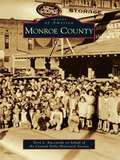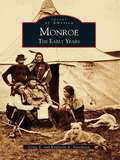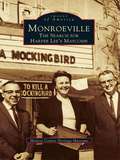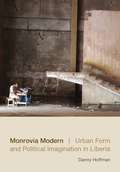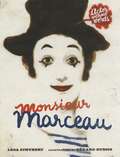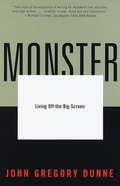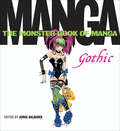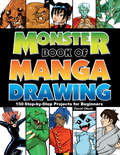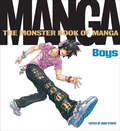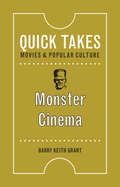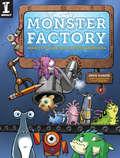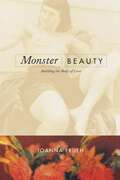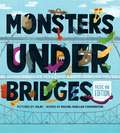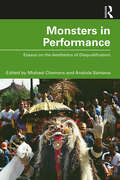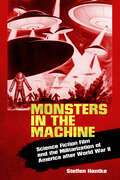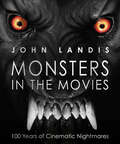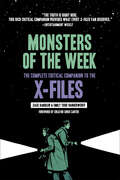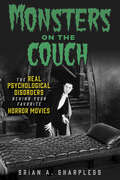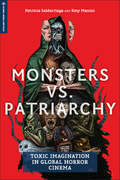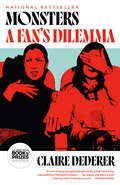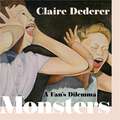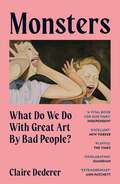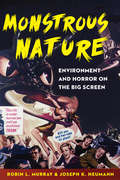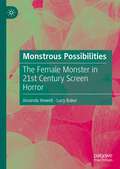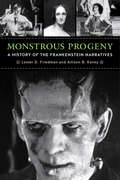- Table View
- List View
Monroe County
by Terri L. Kuczynski Central Delta Historical SocietyMonroe County is situated on some of the richest soil in the Arkansas Delta region and has supported an agrarian culture for more than two centuries. The initial survey point of the Louisiana Purchase lies here in a black-water swamp, marking the origin of nearly every township boundary and property line in 15 states. The Great Flood of 1927 devastated the county, destroying vast acres of farmland and displacing thousands of families. Monroe County is home to two large wildlife management areas, including the Cache River Wildlife Management area, where the ivory-billed woodpecker, once considered extinct, was sighted in 2004. However, the real history of Monroe County is a story of the brave and diligent people that cleared the land and forged a new life through prosperity and drought, driven by their love of family and friends.
Monroe: The Early Years (Images of America)
by Kimberly A. Hutchison Craig E. HutchisonOne of the oldest settlements in Michigan, Monroe is a treasure trove of American history. Legacies of Native American cultures, French settlement, the War of 1812, the Civil War, and 19th-century progress still echo through its beautiful streets and structures. The Monroe area is nationally known as the site of the Battles and Massacre of the River Raisin, among the largest engagements of the War of 1812. But perhaps it is better known as the home of General George Armstrong Custer, the great Civil War hero who valiantly led Union troops to victory, only to perish at the Battle of Little Bighorn.This book uses rare images and historical insights to document and celebrate Monroe's early development, military legacy, legendary figures, and architectural splendor.
Monroeville: The Search for Harper Lee's Maycomb
by Monroe County Heritage MuseumsFor 39 years, people from all over the world and all walks of life have come to the small town of Monroeville, Alabama, in search of a place called Maycomb. They come in search of a story that have moved millions of people with its enduring message, and in search of the world of the storyteller. Monroeville: The Search for Harper Lee's Maycomb explores the relationship between Harper Lee's hometown and the setting of her Pulitzer Prize-winning novel, To Kill a Mockingbird. Born in response to the curiosities of visitors to the Monroe County Heritage Museums, this book explores the parallels between the tow worlds through vintage images and informative captions. Included are photographs of the Lee family and the author in her early years; the sights of Monroeville that undoubtedly inspired the setting of Maycomb; the cast of the Oscar-winning film adaptation that premiered in 1963; and the Mockingbird Players, a group of Monroeville residents who, each year in May, present an authentic production of the two-act play adapted by Christopher Sergel. Among the visitors to Monroeville are teachers and lawyers making a pilgrimage to Atticus' courtroom, scholars in search of unanswered questions, and fans of the novel trying to capture a glimpse of Scout's world. The Monroe County Heritage Museums, under the direction of Kathy McCoy, made this possible in 1991 with the opening of the Old Courthouse Museum on the town square. Visitors now leave Monroeville feeling as if they walked the streets of Maycomb on a hot summer day, enchanted by the imagined presence of Sout, Jem, and Dill exploring their neighborhood in an era of tumultuous change.
Monrovia Modern: Urban Form and Political Imagination in Liberia
by Danny HoffmanIn Monrovia Modern Danny Hoffman uses the ruins of four iconic modernist buildings in Monrovia, Liberia, as a way to explore the relationship between the built environment and political imagination. Hoffman shows how the E. J. Roye tower and the Hotel Africa luxury resort, as well as the unfinished Ministry of Defense and Liberia Broadcasting System buildings, transformed during the urban warfare of the 1990s from symbols of the modernist project of nation-building to reminders of the challenges Monrovia's residents face. The transient lives of these buildings' inhabitants, many of whom are ex-combatants, prevent them from making place-based claims to a right to the city and hinder their ability to think of ways to rebuild and repurpose their built environment. Featuring nearly 100 of Hoffman's color photographs, Monrovia Modern is situated at the intersection of photography, architecture, and anthropology, mapping out the possibilities and limits for imagining an urban future in Monrovia and beyond.
Monsieur Marceau: Actor Without Words
by Leda Schubert Gérard DuboisMarcel Marceau, the world's most famous mime, enthralled audiences around the world for more than fifty years. When he waved his hand or lifted his eyebrow he was able to speak volumes without ever saying a word. But few know the story of the man behind those gestures... Distinguished author Leda Schubert and award-winning artist Gerard DuBois bring their own artistry to this gorgeously written and illustrated picture book biography.
Monster
by John Gregory DunneMonster is John Gregory Dunne's mordant account of the eight years it took to get the 1996 Robert Redford/Michelle Pfeiffer film Up Close & Personal made. A bestselling novelist, Dunne has a cold eye, perfect pitch for the absurdities of Hollywood, and sharp elbows for the film industry's savage infighting. 192 pp. Author tour & national ads. 25,000 print.
Monster Book of Manga
by Jorge BalaguerAn extraordinary new volume in the bestselling Monster Book of Manga books Gothic features thirty dark characters and easy-to-follow instructions teaching you how to create them.The Monster Book of Manga: Gothic is the ultimate guide to creating the hottest, most cutting-edge manga. Inside you'll find thirty devious and mysterious manga characters, along with step-by-step instructions taking you from initial line drawings to graphic, full-color designs. The characters include rebellious and subversive youth—from rock stars and dancers to gothic cheerleaders and a beautiful, modernized gothic Lolita. There are also dangerous cyberpunks, vampires, and warriors, as well as a gothic space queen and a satanic being. Unique in its content and the elegance of its characters, The Monster Book of Manga: Gothic is the only comprehensive guide to creating gothic manga and a must-have for all new and experienced manga artists alike.
Monster Book of Manga Drawing: 150 Step-by-Step Projects for Beginners
by David OkumIt's the most mammoth book of manga drawing EVER! If there's one key to drawing manga, it's GO BIG--starting with this humongous book of step-by-step instruction and inspiration. Compiled from nearly 10 years of best-selling books by David Okum, these pages are teeming with the most popular characters--ninjas, wizards, cyberpunk kids, space pirates, evil queens, mindless goons and more--all broken down into easy-to-follow steps, from pencil sketch to full-color renderings. Throughout, you'll find expert advice on rendering dynamic poses, expressions, weapons, clothing, cool modes of transportation and more. Hero or villain, chibi or giant, mecha or mega-cute...you'll learn how to draw them all manga-style. Simply add your one-of-a-kind twist, and POW! There's no stopping you! 150 step-by-step demos make it easy to learn by doing! 30+ memorable superheroes and the villains that make their lives difficult 30+ terrific monsters--killer robots, zombies, mutant cyborgs, vampires and the like 30+ varieties of fantasy characters, including goblins, elves, witches and skeleton warriors Sidekicks, thugs and other supporting characters to round out your cast PLUS a whole chapter of wicked-cool martial arts moves for action-filled fight scenes! Join the LEGIONS of budding artists who have learned to draw with David Okum!
Monster Book of Manga: Boys
by Ikari StudioFrom the prestigious comic illustration studio Ikari comes the ultimate guide to how to draw manga boys. Each vivid, full-color character illustration is broken down into six stages accompanied by step-by-step instructions to take the artist from initial black-and-white sketches to a vibrant, fully costumed collection of characters. This detailed manual is a perfect instruction guide for beginning and advanced manga artists alike. It pairs advanced illustration techniques with step-by-step instructions, and features an original cast of manga boys and men, fierce and timeless enough to take the spotlight of any manga cartoon.
Monster Cinema (Quick Takes: Movies and Popular Culture)
by Barry Keith GrantMonster Cinema introduces readers to a vast menagerie of movie monsters. Some are gigantic, like King Kong or the kaiju in Pacific Rim, while others are microscopic. Some monsters appear uncannily human, from serial killers like Norman Bates to the pod people in Invasion of the Body Snatchers. And of course, other movie monsters like demons, ghosts, vampires, and witches emerge from long folklore traditions. Film expert Barry Keith Grant considers what each type of movie monster reveals about what it means to be human and how we regard the world. Armed with an encyclopedic knowledge of film history, Grant presents us with an eclectic array of monster movies, from Nosferatu to Get Out. As he discovers, although monster movies might claim to be about Them!, they are really about the capacity for horror that lurks within each of us.
Monster Factory: Draw Cute and Cool Cartoon Monsters
by Ernie HarkerHow to Draw Monsters!(No humans were harmed in the making of this book.)Looking for a way to unleash your inner beast? It's easy with these wonderfully weird and relatively harmless creatures.Head inside the Monster Factory to:Draw 43 fun and feisty monsters step by step!Learn to draw different eyes, mouths, horns, legs and feet, and then mix them up to invent your very own, unique and scary creations.Create four breeds of monsters, including freestyle, alien, mashups and robots.Spot monster-making inspiration all around you, from animals and insects to jelly beans and toasters. Inside are some of the most likeable (and freaky) fiends you'll ever encounter--from Stephanie, who just wants to hug, to Patience, the bug-eating rock, to Peeperpillar, a cute caterpillar-parakeet. They come from the quirky minds of three professional monster artists, here to share their secret techniques and character-building tips. With a fun, anything-goes approach to monster-making, they show you how to bring to life the monsters running wild in your own imagination.
Monster/Beauty: Building the Body of Love
by Joanna FruehThis daring, intensely personal book challenges both conventional and feminist ideas about beauty by asking us to take pleasure in beauty without shame, and to see and feel the erotic in everyday life. Bringing together her varied experiences as a poet, art historian, bodybuilder, and noted performance artist, Joanna Frueh shows us how to move beyond society's equation of youth with beauty toward an aesthetic for the fully erotic human being. A lush combination of autobiography, theory, photography, and poetry, this book continues to develop the ideas about the erotic, beauty, older women, sex, and pleasure that Frueh first addressed in Erotic Faculties. Monster/Beauty examines these issues using a provocative, often explicit, set of examples. Frueh admiringly looks at the bodies and mindsets of midlife female bodybuilders, rethinks the vampire, and revises our ideas about traditional models of beauty, such as Aphrodite. Above all, she boldly brings her personal experience into the text, weaving her reflections on female sensuality with contemporary theory. These linked essays are as much a performance as they are a discussion, breaking down the barriers between the personal and the academic, and the erotic and the intellectual. Frueh writes passionately and beautifully, and the result is a much-needed exploration of beauty myths and taboos.
Monsters Under Bridges
by Rachel Roellke CoddingtonFrom Portland, Oregon to Seattle, Washington to Vancouver, BC, this playful picture book introduces misunderstood monsters and the Pacific Northwest bridges they call home. Meet Irving the Noble Vegetarian who lives under the Astoria-Megler Bridge and smells like vegetables and hair gel. Or the Flixies, a group of winged pixie creatures who live under the Fremont Bridge in Portland. Each monster takes on the history and environment of their home, making Monsters Under Bridges engaging as well as educational. Find out who these lovable monsters are, how they spend their time, what they like to eat, and more in this fun monster almanac!
Monsters in Performance: Essays on the Aesthetics of Disqualification
by Analola Santana Michael ChemersMonsters in Performance boasts an impressive range of contemporary essays that delve into topical themes such as race, gender, and disability, to explore what constitutes monstrosity within the performing arts. These fascinating essays from leading and emerging scholars explore representation in performance, specifically concerning themselves with attempts at social disqualification of "undesirables." Throughout, the writers employ the concept of "monstrosity" to describe the cultural processes by which certain identities or bodies are configured to be threateningly deviant. The editors take a range of previously isolated critical inquiries – including bioethics, critical race studies, queer studies, and televisual studies - and merge them to create an accessible and dynamic platform which unifies these ranges of representations. The global scope and interdisciplinary nature of Monsters in Performance renders it an essential book for Theatre and Performance students of all levels as well as scholars; it will also be an enlightening text for those interested in monstrosity and Cultural Studies more broadly.
Monsters in the Machine: Science Fiction Film and the Militarization of America after World War II
by Steffen HantkeDuring the 1950s and early 1960s, the American film industry produced a distinct cycle of films situated on the boundary between horror and science fiction. Using the familiar imagery of science fiction--from alien invasions to biological mutation and space travel--the vast majority of these films subscribed to the effects and aesthetics of horror film, anticipating the dystopian turn of many science fiction films to come. Departing from projections of American technological awe and optimism, these films often evinced paranoia, unease, fear, shock, and disgust. Not only did these movies address technophobia and its psychological, social, and cultural corollaries; they also returned persistently to the military as a source of character, setting, and conflict. Commensurate with a state of perpetual mobilization, the US military comes across as an inescapable presence in American life.Regardless of their genre, Steffen Hantke argues that these films have long been understood as allegories of the Cold War. They register anxieties about two major issues of the time: atomic technologies, especially the testing and use of nuclear weapons, as well as communist aggression and/or subversion. Setting out to question, expand, and correct this critical argument, Hantke follows shifts and adjustments prompted by recent scholarly work into the technological, political, and social history of America in the 1950s. Based on this revised historical understanding, science fiction films appear in a new light as they reflect on the troubled memories of World War II, the emergence of the military-industrial complex, the postwar rewriting of the American landscape, and the relative insignificance of catastrophic nuclear war compared to America's involvement in postcolonial conflicts around the globe.
Monsters in the Movies: 100 Years of Cinematic Nightmares
by John LandisFrom B-movie bogeymen and outer space oddities to big-budget terrors, Monsters in the Movies by legendary filmmaker John Landis showcases the greatest monsters ever to creep, fly, slither, stalk, or rampage across the Silver Screen! Landis provides his own fascinating and entertaining insights into the world of moviemaking, while conducting in-depth "conversations" with leading monster makers, including David Cronenberg, Christopher Lee, John Carpenter, and Sam Raimi — to discuss some of the most petrifying monsters ever seen. He also surveys the historical origins of the archetypal monsters, such as vampires, zombies, and werewolves, and takes you behind the scenes to discover the secrets of those special-effects wizards who created such legendary frighteners as King Kong, Dracula, and Halloween's Michael Myers. With more than 1000 stunning movie stills and posters, this book is sure to keep even the most intense fright-seekers at the edge of their seats for hours!
Monsters of the Week: The Complete Critical Companion to The X-Files
by Zack Handlen Emily Todd VanDerWerffThe complete critical companion to The X-Files, covering every episode and both films and featuring interviews with screenwriters and stars.In Monsters of the Week: The Complete Critical Companion to The X-Files, TV critics Zack Handlen and Emily Todd VanDerWerff look back at exactly what made the long-running cult series so groundbreaking. Packed with insightful reviews of every episode—including the tenth and eleventh seasons and both major motion pictures—Monsters of the Week leaves no mystery unsolved and no monster unexplained. This crucial collection includes a foreword by series creator Chris Carter as well as exclusive interviews with some of show’s stars and screenwriters, including Carter, Vince Gilligan, Mitch Pileggi, James Wong, Robert Patrick, Darin Morgan, and more. Monsters of the Week is the definitive guide to The X-Files—whether you’re a lifelong viewer or a new fan uncovering the conspiracy for the first time. “This rich critical companion provides what evert X-Files fan deserves.” —Entertainment Weekly “The X-Files is my favorite show and Zack and Emily are my favorite reviewers of my favorite show and this is my favorite quote about it.” —Kumail Nanjiani, writer and star of The Big Sick; creator of The X-Files Files podcast“If Mulder and Scully had access to this terrific book, they would’ve solved every mystery of The X-Files in a single season. . . . The truth is in here!” —Damon Lindelof, co-creator of Lost and The Leftovers
Monsters on the Couch: The Real Psychological Disorders Behind Your Favorite Horror Movies
by Brian A. SharplessHorror movies can reveal much more than we realize about psychological disorders—and clinical psychology has a lot to teach us about horror. Our fears—mortality, failure, loneliness—can be just as motivating as our wishes or desires. Horror movie characters uniquely reveal all of these to a wide audience. If explored in an honest and serious manner, our fears have the potential to teach us a great deal about ourselves, our culture, and certainly other people. From psychologist, researcher, and horror film enthusiast Brian A. Sharpless comes Monsters on the Couch, an exploration into the real-life psychological disorders behind famous horror movies. Accounts of clinical syndromes every bit as dramatic as those on the silver screen are juxtaposed with fascinating forays into the science and folklore behind our favorite movie monsters. Horror fans may be obsessed with vampires, werewolves, zombies, and the human replacements from Invasion of the Body Snatchers, but even many medical professions may not know about the corresponding conditions of Renfield's syndrome, clinical lycanthropy, Cotard's syndrome, and the misidentification delusions. Some of these disorders are surprisingly common in the general population. For instance, a number of people experience isolated sleep paralysis, a disorder implicated in ghost and alien abduction beliefs.As these tales unfold, readers not only learn state-of-the-art psychological science but also gain a better understanding of history, folklore, and how Hollywood often—but not always—gets it wrong when tackling these complex topics.
Monsters vs. Patriarchy: Toxic Imagination in Global Horror Cinema (Global Media and Race)
by Patricia Saldarriaga Emy ManiniAcross the globe, the violent effects of patriarchy are manifest. Women, trans people, gender-nonconforming people, and the racialized Other are regularly subjected to physical danger, beginning with the denial of vitally important health care, and, in its most horrific form, rape, trafficking, and murder. Monsters vs. Patriarchy links these real-world horrors to the monstrification and dehumanization of people as expressed in contemporary global cinema. This monstrification has been achieved through a toxic imagination attributed to women, a trait that historically referred to the power of women to negatively affect others, including their own children in the womb, with only the use of their imagination. This process reflects the misogynist and racist world in which we live, where female bodies, people of color, and alternative identities represent a threat to patriarchal power. Monsters vs. Patriarchy examines female monstrosity as it appears in horror films from around the world and considers specific political, scientific, and historical contexts to better understand how we construct and reconstruct monstrosity, using an intersectional approach to examine the imposition of gender and racial hierarchies that support national power structures. The authors contend that monstrous female cinematic subjects, including ghosts, witches, cannibals, and posthuman beings, are becoming empowered, using the tools of their monstrification to smash the colonial, white supremacist, and misogynist structures that created them.
Monsters: A Fan's Dilemma
by Claire DedererA NEW YORK TIMES NOTABLE BOOK • NATIONAL BESTSELLER • A timely, passionate, provocative, blisteringly smart interrogation of how we make and experience art in the age of cancel culture, and of the link between genius and monstrosity. Can we love the work of controversial classic and contemporary artists but dislike the artist?"A lively, personal exploration of how one might think about the art of those who do bad things" —Vanity Fair • "[Dederer] breaks new ground, making a complex cultural conversation feel brand new." —Ada Calhoun, author of Also a Poet From the author of the New York Times best seller Poser and the acclaimed memoir Love and Trouble, Monsters is &“part memoir, part treatise, and all treat&” (The New York Times). This unflinching, deeply personal book expands on Claire Dederer&’s instantly viral Paris Review essay, "What Do We Do with the Art of Monstrous Men?" Can we love the work of artists such as Hemingway, Sylvia Plath, Miles Davis, Polanski, or Picasso? Should we? Dederer explores the audience's relationship with artists from Michael Jackson to Virginia Woolf, asking: How do we balance our undeniable sense of moral outrage with our equally undeniable love of the work? Is male monstrosity the same as female monstrosity? And if an artist is also a mother, does one identity inexorably, and fatally, interrupt the other? In a more troubling vein, she wonders if an artist needs to be a monster in order to create something great. Does genius deserve special dispensation? Does art have a mandate to depict the darker elements of the psyche? And what happens if the artist stares too long into the abyss? Highly topical, morally wise, honest to the core, Monsters is certain to incite a conversation about whether and how we can separate artists from their art.&“Monsters leaves us with Dederer&’s passionate commitment to the artists whose work most matters to her, and a framework to address these questions about the artists who matter most to us." —The Washington PostA Best Book of the Year: The New York Times, NPR, The Washington Post, The New Yorker, Vulture, Elle, Esquire, Kirkus
Monsters: A Fan’s Dilemma
by Claire DedererA passionate, provocative and blisteringly smart interrogation of how we experience art in the age of #MeToo, and whether we can separate an artist's work from their biography.What do we do with the art of monstrous men? Can we love the work of Roman Polanski and Michael Jackson, Hemingway and Picasso? Should we love it? Does genius deserve special dispensation? Is history an excuse? What makes women artists monstrous? And what should we do with beauty, and with our unruly feelings about it?Claire Dederer explores these questions and our relationships with the artists whose behaviour disrupts our ability to apprehend the work on its own terms. She interrogates her own responses and her own behaviour, and she pushes the fan, and the listener, to do the same. Morally wise, deeply considered and sharply written, Monsters gets to the heart of one of our most pressing conversations.(P) 2023 Penguin Audio
Monsters: A Fan’s Dilemma
by Claire Dederer'An exhilarating, shape-shifting exploration of the perilous boundaries between art and life' JENNY OFFILL'An incredible book, the best work of criticism I have read in a very long time' NICK HORNBY'Wise and bold and full of the kind of gravitas that might even rub off' LISA TADDEOA passionate, provocative and blisteringly smart interrogation of how we experience art in the age of #MeToo, and whether we can separate an artist's work from their biography.What do we do with the art of monstrous men? Can we love the work of Roman Polanski and Michael Jackson, Hemingway and Picasso? Should we love it? Does genius deserve special dispensation? What makes women artists monstrous? And what should we do with beauty, and with our unruly feelings about it?Claire Dederer explores these questions and our relationships with the artists whose behaviour disrupts our ability to understand the work on its own terms. She interrogates her own responses and behaviour, and she pushes the fan, and the reader, to do the same. Morally wise, deeply considered and sharply written, Monsters gets to the heart of one of our most pressing conversations.'A blisteringly erudite and entertaining read . . . It's a book that deserves to be widely read and will provoke many conversations' NATHAN FILER'Fascinating . . . Dederer poses so many topical questions, plays with so many pertinent ideas, that I'm still thinking about this book long after I finished it' CLAIRE FULLER
Monstrous Nature: Environment and Horror on the Big Screen
by Robin L. Murray Joseph K. HeumannGodzilla, a traditional natural monster and representation of cinema’s subgenre of natural attack, also provides a cautionary symbol of the dangerous consequences of mistreating the natural world—monstrous nature on the attack. Horror films such as Godzilla invite an exploration of the complexities of a monstrous nature that humanity both creates and embodies. Robin L. Murray and Joseph K. Heumann demonstrate how the horror film and its offshoots can often be understood in relation to a monstrous nature that has evolved either deliberately or by accident and that generates fear in humanity as both character and audience. This connection between fear and the natural world opens up possibilities for ecocritical readings often missing from research on monstrous nature, the environment, and the horror film. Organized in relation to four recurring environmental themes in films that construct nature as a monster—anthropomorphism, human ecology, evolution, and gendered landscapes—the authors apply ecocritical perspectives to reveal the multiple ways nature is constructed as monstrous or in which the natural world itself constructs monsters. This interdisciplinary approach to film studies fuses cultural, theological, and scientific critiques to explore when and why nature becomes monstrous.
Monstrous Possibilities: The Female Monster in 21st Century Screen Horror
by Lucy Baker Amanda HowellThis book focuses on how the abject spectacle of the ‘monstrous feminine’ has been reimagined by recent and contemporary screen horrors focused on the desires and subjectivities of female monsters who, as anti-heroic protagonists of revisionist and reflexive texts, exemplify gendered possibility in altered cultures of 21st century screen production and reception. As Barbara Creed notes in a recent interview, the patriarchal stereotype of horror that she named ‘the monstrous-feminine’ has, decades later, ‘embarked on a life of her own’. Focused on this altered and renewed form of female monstrosity, this study engages with an international array of recent and contemporary screen entertainments, from arthouse and indie horror films by emergent female auteurs, to the franchised products of multimedia conglomerates, to 'quality' television horror, to the social media-based creations of horror fans working as ‘pro-sumers’. In this way, the monograph in its organisation and scope maps the converged and rapidly changing environment of 21st century screen cultures in order to situate the monstrous female anti-hero as one of its distinctive products.
Monstrous Progeny: A History of the Frankenstein Narratives
by Lester D. Friedman Allison B. KaveyMary Shelley's 1818 novel Frankenstein is its own type of monster mythos that will not die, a corpus whose parts keep getting harvested to animate new artistic creations. What makes this tale so adaptable and so resilient that, nearly 200 years later, it remains vitally relevant in a culture radically different from the one that spawned its birth? Monstrous Progeny takes readers on a fascinating exploration of the Frankenstein family tree, tracing the literary and intellectual roots of Shelley's novel from the sixteenth century and analyzing the evolution of the book's figures and themes into modern productions that range from children's cartoons to pornography. Along the way, media scholar Lester D. Friedman and historian Allison B. Kavey examine the adaptation and evolution of Victor Frankenstein and his monster across different genres and in different eras. In doing so, they demonstrate how Shelley's tale and its characters continue to provide crucial reference points for current debates about bioethics, artificial intelligence, cyborg lifeforms, and the limits of scientific progress. Blending an extensive historical overview with a detailed analysis of key texts, the authors reveal how the Frankenstein legacy arose from a series of fluid intellectual contexts and continues to pulsate through an extraordinary body of media products. Both thought-provoking and entertaining, Monstrous Progeny offers a lively look at an undying and significant cultural phenomenon.
